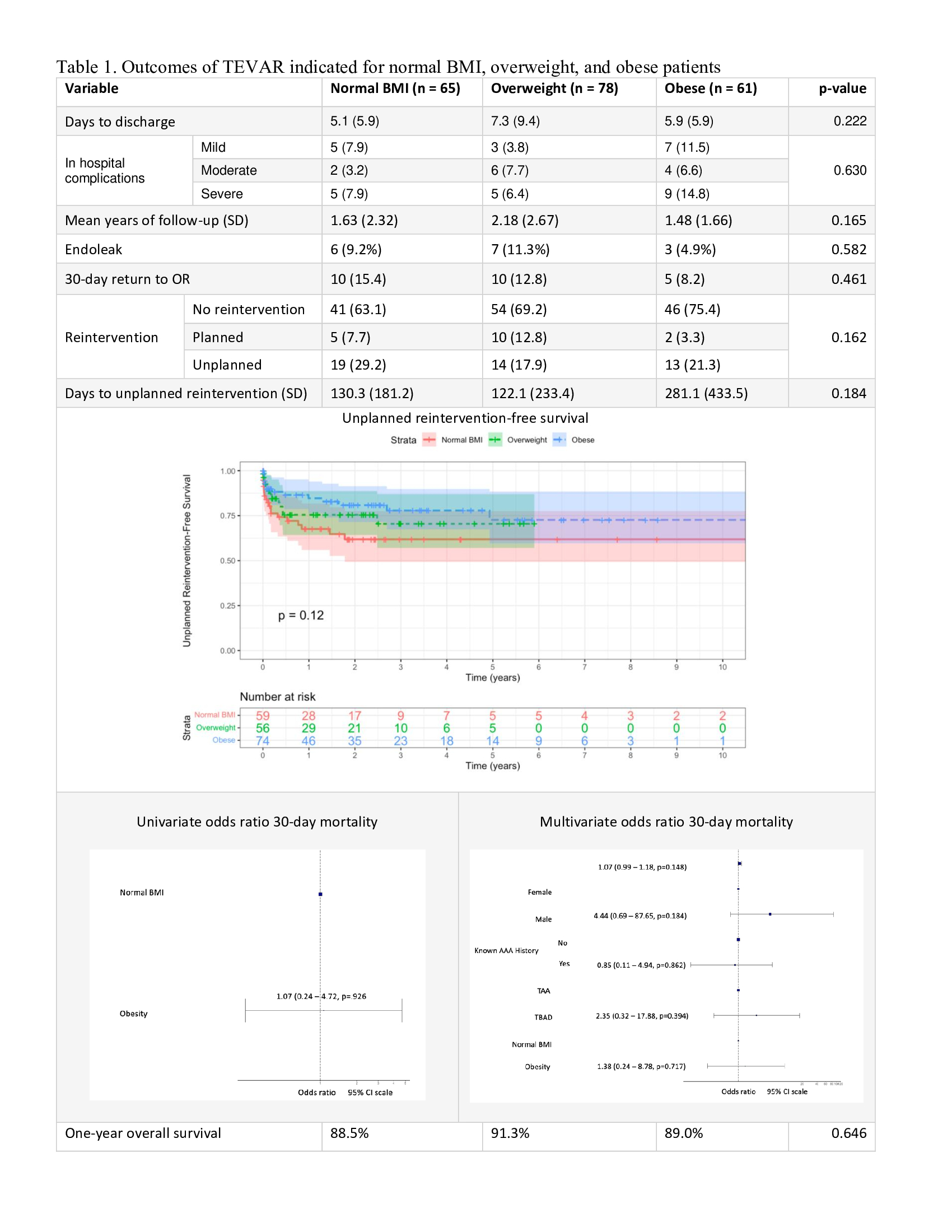Obese And Overweight Patients Are Not At Higher Risk For Complication Or Mortality After TEVAR
Peter V. Cooke, BA1, Halbert Bai, MPH1, Justin M. George, MD2, Christopher M. Faries, BA1, Windsor Ting, MD2, Ajit Rao, MD2, Michael L. Marin, MD2, Peter L. Faries, MD2, Rami O. Tadros, MD2.
1Icahn School of Medicine at Mount Sinai, New York, NY, USA, 2Division of Vascular Surgery, Mount Sinai Hospital, New York, NY, USA.
Objective: Studies reporting outcomes of TEVAR in obese and overweight patients are scarce. Our objective was to determine the rate of complications, reintervention, and short-term mortality in overweight and obese patients undergoing TEVAR.
Methods: Patients undergoing TEVAR from August 2001 to January 2020 were retrospectively analyzed. We stratified patients into three cohorts based on BMI: Normal (18.5 - 25 kg/m2), Overweight (25 - 30 kg/m2), and Obese (> 30 kg/m2). We used SVS guideline standards to report intraoperative, in-hospital, and post-discharge complications. Reinterventions associated with the index TEVAR procedure were assessed. Overweight patients were excluded from the logistic regression analysis of 30-day mortality, as no overweight patients died in this period.
Results: Among 204 patients fitting the study criteria, we identified 65 with normal BMI, 78 overweight, and 61 obese patients. While the obese patients were younger than the overweight and normal BMI patients (mean age 62.2 vs. 66.7 vs. 70.7, respectively, p=0.003), the cohorts had similar demographics and comorbidities. For TEVAR indication, the obese cohort had the highest percentage of patients with type b aortic dissection (36.4%), while the normal BMI cohort had the higher proportion of patients with isolated thoracic aortic aneurysm (63.9%). Other intraoperative details, including complications, did not significantly differ between cohorts. Postoperatively, in-hospital complications, post-discharge complications, and thirty-day return to the operative room did not differ significantly between normal, overweight, and obese patients. The number of unplanned reinterventions was similar between cohorts. Odds of reintervention did not differ significantly between cohorts, both on univariate and multivariate analysis. Log-rank test of Kaplan Meier analysis revealed no difference in reintervention-free survival (p = 0.22). Thirty-day mortality and 1-year overall survival were similar across cohorts. Both univariate and multivariate logarithmic regression revealed no difference in likelihood of 30-day mortality between the obese and normal cohort. One-year overall survival was also similar between groups.
Conclusion: In this study comparing normal, overweight, and obese patients, there were no measurable differences in complications, reinterventions, or mortality. The results of this study suggest that vascular surgeons can perform TEVAR across a spectrum of BMI without compromising outcomes. 
Back to 2022 Karmody Posters
